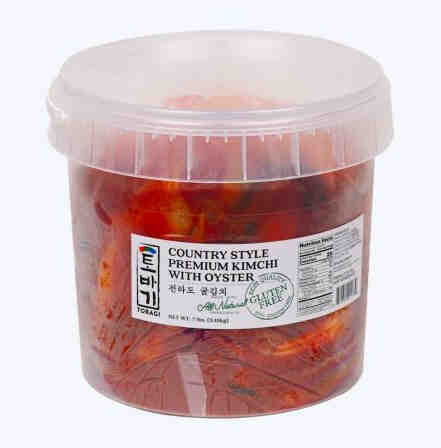Types of Kimchi
A study done in ‘95 (sorry, it’s in Korean) records the number of variety in kimchi at 336. Koreans define “kimchi” as being salt-fermented vegetables (cabbage, radish and cucumber being most common) mixed with various seasonings (like red pepper powder, garlic, ginger). However, there are kimchi types that are not fermented and merely preserved in salt with added seasonings which can be eaten right away.
The word that precedes the term “kimchi” is the descriptor of the actual type.
It is safe to say that most Koreans living in Korea have not have tried all the types of kimchi listed in this list. The most obvious reason being that some will be regional varieties, using regional vegetation with their twist on seasoning combinations. Most are also not mass-produced by kimchi-producing companies because it doesn’t have mass appeal (recognition).
The list is also far from exhaustive as the definition of “kimchi” is broad and is up to an individual’s creativity and resourcefulness. New kimchi types can be invented at any time. Edit: This list also includes JJANGAJJI (vegetables usually pickled in a soy sauce mixture).
Differences in kimchi type may vary by ingredients in a recipe or more likely by the primary vegetable used. Koreans will also refer to kimchi by different names (dependant on region) or by the season it’s usually eaten or by what it’s eaten with. It can be a frustrating experience to exactly pin down kimchi types.
Categories of kimchi included in the study were:
Cabbage
Radish
Cucumber
Fruit
Seaweed
Seafood
배추김치 Cabbage kimchi
The most common type of kimchi is made from Chinese cabbage. Thought to be a natural hybrid (source: Wiki) formed from turnips and bok-choy, it is juicy and rather sweet.
Salted and seasoned with mostly Korean red pepper powder which gives it that classic red colour and spicy flavour. According to the study, there are 91 types of kimchi made from this commonly used cabbage in Asia.
Cabbage Types commonly used for Kimchi
Chinese Cabbage vs Green Cabbage
Asian Cabbage Varieties
배추 Chinese Cabbage: Large head, leafy. Also called Napa Cabbage or Wombok (Australia, Philipphines).
봄동, 얼갈이, 하루나 Other Leafy Cabbage.
양배추 Green Cabbage: Common Western cabbage we see at the store.
백김치 Baek (White) Kimchi and 나박김치 Nabak Kimchi
This may also be referred to as Water Kimchi or Summer Kimchi as it is light and refreshing. There is virtually no spice-level in this particular type and is very popular with children. The sweetness of the cabbage really shines and people who dislike fish sauce will enjoy this odour-free kimchi.
Although traditionally made without sugar, this type of water kimchi made today will often contain some sort of sugar.
무김치 radish Kimchi
Radish is the second most commonly used kimchi vegetable. Radish also imparts a sweet aftertaste, but is most beloved for its incredible crunch.
Cut into cubes, it becomes 깍두기 (Kakkdugi).
총각김치 Chong-Gak Kimchi (Bachelor Kimchi)
Long ago, girls and boys kept their hair long and braided it until they were married. Because this small radish has stems that resemble that childhood braid, it’s called Chong-Gak or Bachelor Kimchi.
무생채 Julienned Radish Kimchi
Commonly referred to as Radish “Salad” online, I prefer to call it kimchi as I wouldn’t eat this like a salad. Like all kimchi, it is much too salty. It is meant to showcase the freshness of the radish, but it really is an accompaniment to rice or meats. There are 2 varieties, it can either be white (salt, sugar, vinegar) or red (salt, garlic, GOCHUGARU).
You may have seen and enjoyed this at the Korean BBQ restaurant.
동치미 Radish Water Kimchi
Like Baek (White) Kimchi, this is especially refreshing and light in the summer months. Dongchimi is made with lots of water, flavoured with garlic and salt (Korean pear, ginger, green onions) and is another child (newbie) favourite.
A delicious taste most will enjoy, it pairs with grilled meats and Korean chilled noodles (냉면 Neng-Myun) exceptionally well. It offers a pickle-like experience without the sourness of vinegar and offers a satisfying crunch.
오이김치 Cucumber Kimchi
Cucumber kimchi uses Korean cucumbers which have minimal seeds and are on the crisper side. Although technically any cucumber will do, you’ll find if you use large, juicy cucumbers it will not hold the seasonings as well. This is especially so in the case of 오이소박 Whole Cucumber Kimchi (see picture above) where you will be stuffing seasonings inside.
Using field cucumbers or garden cucumbers (the most common type in North America) will require some prep work to remove the seeds and peel the waxy/bitter skin. Simple 오이김치 Cucumber Kimchi (which uses pre-cut cucumbers and does not require stuffing) would be more suitable for very large cucumbers like these or English cucumbers.
Cucumbers made for pickling are reasonable substitutes; Kirby and Persian cucumbers are better and widely accessible.
There are variations like summer kimchi made in water called 오이 물 김치 (Cucumber Water Kimchi). The usual suspects for flavouring appear like garlic (always), chili peppers, fruit like Korean pears and salt. Some recipes will also add sugar- but keep in mind traditionally, kimchi did not contain sugar. This is simply because consumer tastes have changed, but feel free to use or omit as you see fit.
Cucumber kimchi is the favourite runner-up (first place goes to radish) vegetable for making kimchi, and why it has its own category.
Vegetable Kimchi
You can find kimchi made from green onions 파김치 (Pah Kimchi) or chives 부추김치 (Buchu Kimchi) easily at the Korean market. These are another must-have kimchi on a Korean BBQ table. The inherent spiciness of these plants add another layer of flavour that gives a refreshing break when eating greasy foods.
깻잎 겉절이 Perilla Leaf Fresh Kimchi would be a vegetable kimchi and can be prepared with soy sauce or red pepper powder.
There is a strong foraging culture in Korea. Although you will be hard pressed to find a packaged version at a store, if you can get your hands on edible plants like Bellflower Roots 도라지 or Lance Asiabell 더덕, they make delicious kimchi.
There are also varieties that use more commonplace vegetables like eggplant (stuffed), carrots (matchstick), taro root (dehydrated), garlic (cloves) and sweet potatoes (cubed or sliced). Commonplace as these ingredients may be, you won’t find these types of kimchi available at the store. Kimchify edible plants or vegetables available to you! I’ve heard good things about broccoli and kohlrabi.
Fruit Kimchi
Most of the fruit kimchi listed in the study are water kimchi (pickles, really) and sound refreshing and sweet.
This recipe (the above picture from Korean food TV show Altoran) takes apples, pears, mandarins mixed with carrots, cucumbers and watercress stems. The “juice” is mostly water, flavoured with salt, vinegar, lemon juice, pan-fried garlic and sugar.
If you’d like some colour, you can add beet slices which add a pretty pink hue.
On the list are also kimchi made from Korean melon 참외 (Chamweh), Korean apricot 살구 (Salgoo), Korean plum 매실 (Maesil), walnuts (I guess they just put that in the fruit category) and watermelon rind. However, these are more of a pickle variety using vinegar, sugar and soy sauce. This type of soy sauce-flavoured “pickle” is called Jangajji.
Help me pronounce it! “JAHNG - AH - JJEE”
People seem to like experimenting with kimchify-ing everything though, and I have seen kimchi (in the traditional sense including GOCHUGARU red pepper powder and fish sauce) made from everything like pineapples to mangoes, so I guess it’s worth a try if you have the opportunity.
These are also not available at the store and are a DIY type project. Sugar is definitely more prominent in these recipes.
The above Apple Kimchi is from this video, sorry it’s in Korean but all the steps are shown thoroughly.
This is a pretty unusual thing to eat. Personally, I’ve never had them. The types listed on the list sound lightly pickled which I imagine to be palatable, but I feel like fermenting sweet fruits with fish sauce… must be an acquired taste.
Seaweed kimchi
Seaweed is a large part of the Korean diet. It holds incredible benefits (supports the thyroid, full of antioxidants) and is actually quite tasty. I suppose it’s an acquired taste for the uninitiated, but think it a superfood worthy of consideration. Especially for those interested in a plant-based eating lifestyle, this one’s a winner.
There are many varieties of edible seaweed and they vary in texture. Some are soft and soothing (like the seaweed for Korean Birthday Soup- wanna see a simple recipe? Click here) and some are satisfyingly crunchy (like Hijiki, called 톳 Tot in Korean). Dressed in a reduced soy sauce broth, it’s a simple side dish that feels healthy (but tastes good).
Seafood Kimchi
As a seafoodie, I am particularly fond of this type of kimchi. Pictures really don’t do it justice.
If you love hot sauce on your freshly shucked oysters, you will absolutely fall in love. If you find this kimchi at your local Hmart (Country Style Kimchi with Oysters, pictured above), I highly suggest picking some up!
Kimchi containing seafoods (Squid, abalone, some fish types) are premium products because it’s 1. Expensive and 2. Doesn’t last long. Kimchi made with seafood should not be kept for too long as the fresh seafood won’t ferment nicely (would you drink fish sauce straight up?). Best enjoyed fresh and consumed within a week.
It really is a treat to have, and should make it on your kimchi bucket list.
What’s your favourite kimchi? Found any you’d like to try?


















